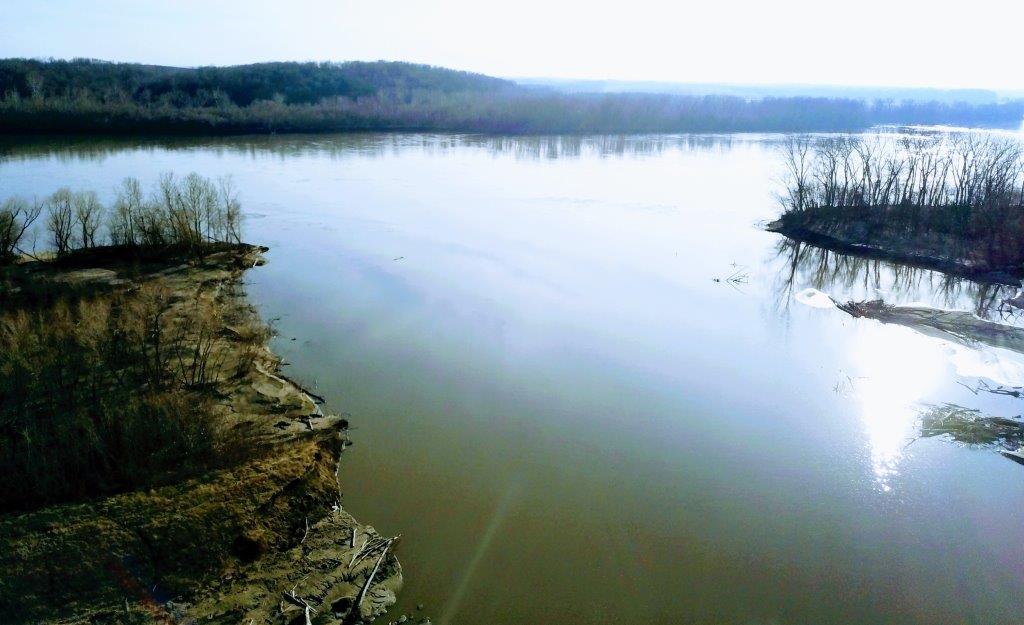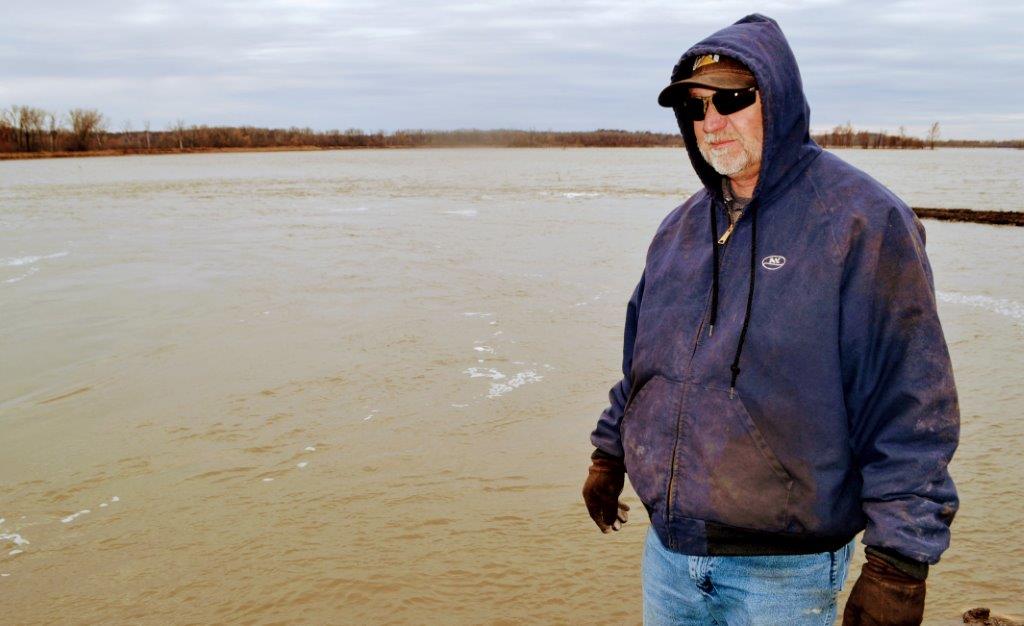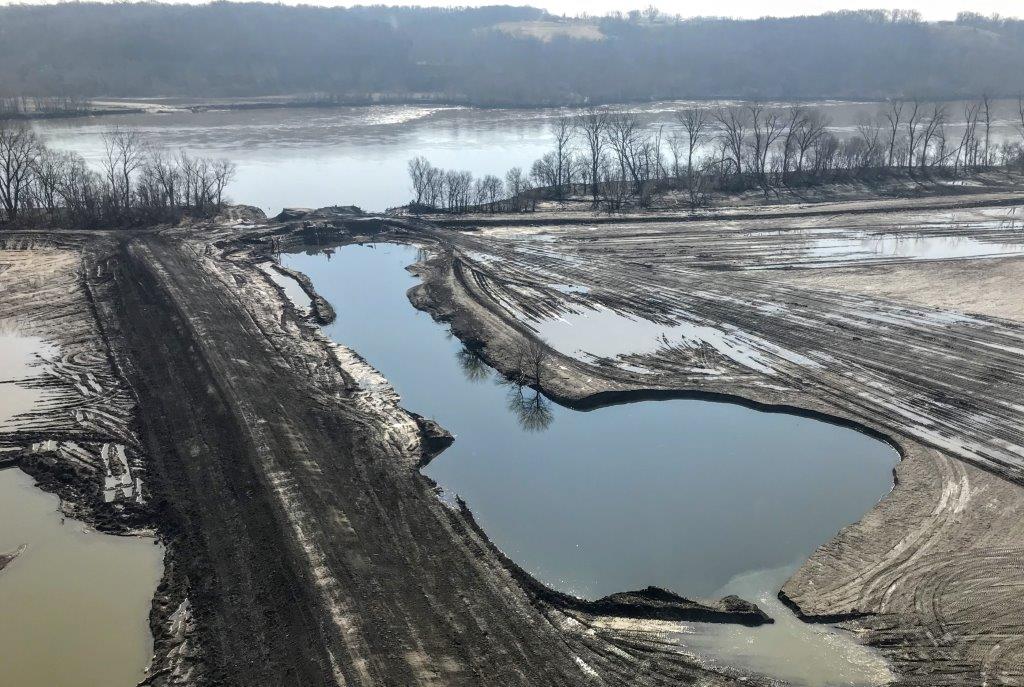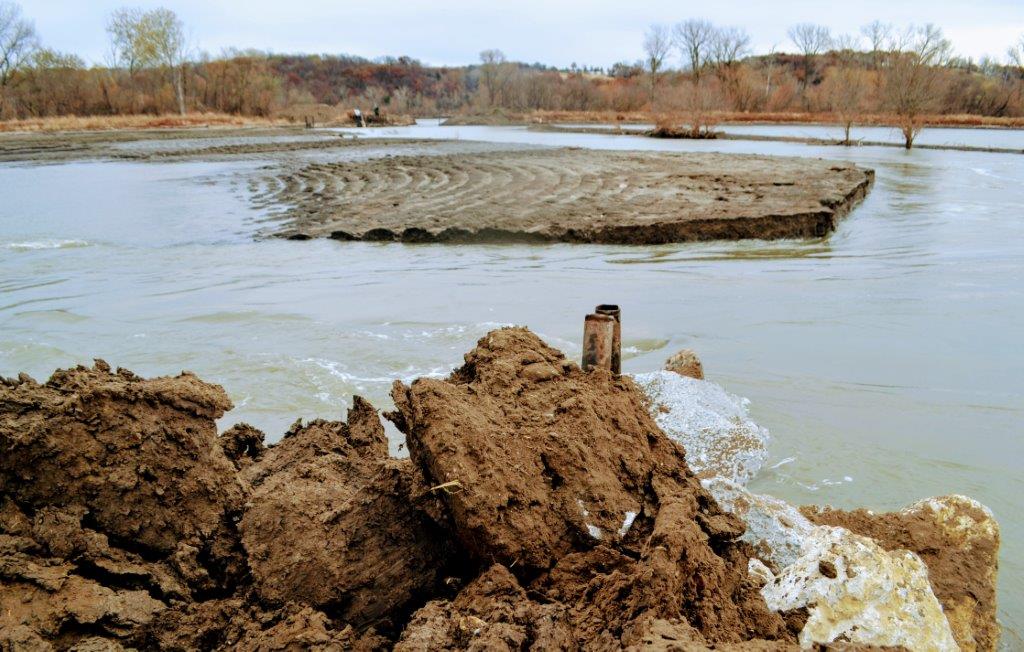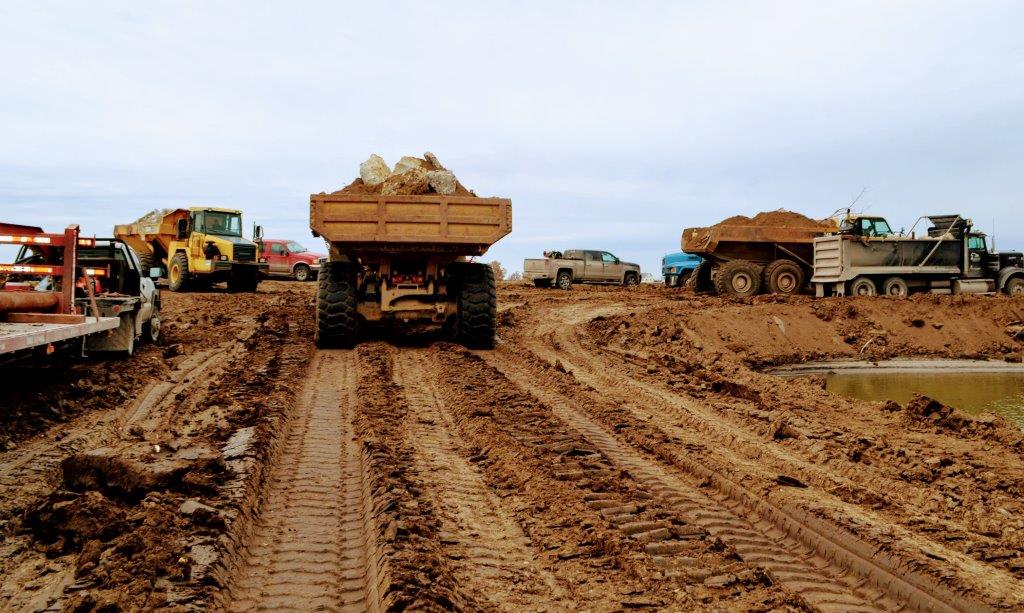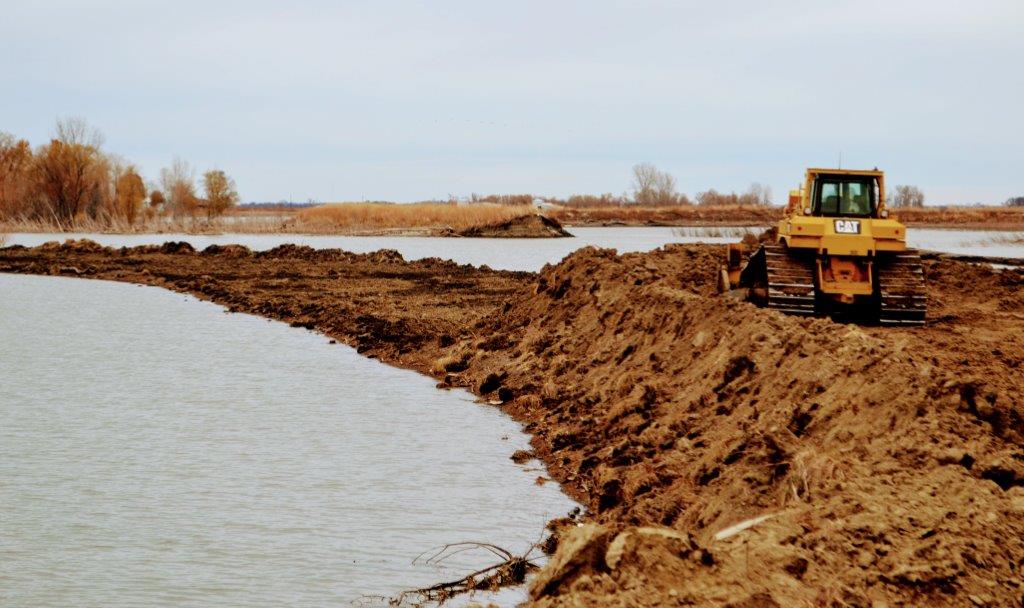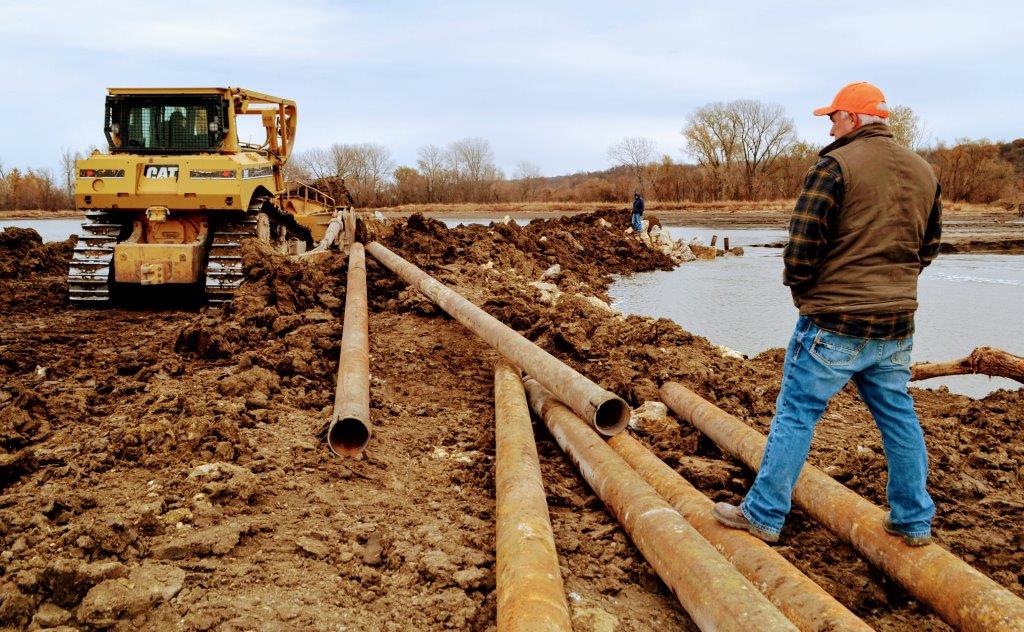Flooded and Forgotten, Missouri Farmers Call Out FEMA

Faith no more. When the Great Flood of 2019 silently swallowed the Midwest, leaving millions of acres submerged along the Missouri River from roughly June to December, a bootstrap band of private citizens charged toward the levee breaks and catastrophic waters to save additional ground from further devastation. Those same citizens—farmers, small businessmen, and private landowners—have since lost all trust in the federal bureaucracy.
As the flood crisis deepened, rural residents in Carroll County, Missouri successfully stemmed a levee overflow with a series of self-funded berms that shielded highways, houses, and towns from additional damage. In return, they asked the Federal Emergency Mandate Agency (FEMA) for a single assurance: good faith. “We didn’t want a thing, except for what they promised us,” says grower Travis Matthews. “FEMA gave us their word to pay for contractors, and we never requested a cent to cover our time, labor or our own equipment. All we asked was for FEMA to keep its promise.”
Two years later, the floodwater has receded, the levee remains under repair, FEMA officials are gone, and the people of Carroll County are left with a merry-go-round of paperwork, FEMA denial letters, and a $1-million-plus bill. Matthews insists Carroll County is merely emblematic: “Our federal government is broken for common people, and there are similar stories in counties across Missouri and in other states. How do you even explain this bureaucratic nightmare and why the government won’t keep its word?”
Matthews’ question tears the scab off a two-year wound and seven steady months of ruin.
Song-and-Dance?
In the northwest quarter of the Show-Me State, Carroll County rubs against the northern banks of the Missouri River, and contains the widest bottoms in the state, a stretch of flat topography ideal for grain cultivation, almost 12 miles wide at some locations, narrowing to 6 miles across in other spots. In 2019, Matthews and his wife, Melinda, farmed in the floodplain south of Carrollton, the county seat, and had 70% of their crops planted in Sugartree Bottom when the river levee broke on June 2, turning 66,000 acres of the county into water-world. (Floodwater had already pushed in several times during May after a winter and spring of steady deluge, but the early June breach was the backbreaker.)
Matthews’ entire sphere of existence, as with many riverine areas in Missouri and surrounding states, turned into a lake that remained in place, at least in part, until the river dropped below flood stage on Dec. 16. In Carroll County, home to roughly 10,000 people, water drowned infrastructure of all stripes, displacing families, swamping 500-plus farming operations, erasing highways, blocking railroad transport, and impeding emergency services. For months, Matthews’ commute matched the same trip taken by his neighbors—a boat trip to town.
As a community, prior to the June break, the Ray-Carroll Levee District had sandbagged, placed rock, and put up plywood for months, even shuttering high schools for sandbag duty, and deploying county prisoners to help shore up the defenses along a 20-mile river stretch, but the levee still faltered in three points, and the influx of water prevented the Corps of Engineers from reaching the main breaks to make a repair. The levee district, led by Matthews as president, proposed a two-pronged strategy to stem the flow: Construct berms to keep the water from taking more ground, and build an access road to provide a path for the Corps to directly access the levee in order to begin repairs.
“We reached out to FEMA ($28.7 billion yearly budget; 20,000 employees) reps for help and had repeated meetings with them, in order to build a temporary berm and an access road to stop the flow of water and get to the primary levee,” Matthews says. “FEMA was enthusiastic. They told us we were eligible for funding, and they started working with us throughout the process, giving us paperwork and telling us what to do step-by-step.”
“FEMA laid out their own plan for a temporary berm, actually a different plan from what the district had figured, and we used their plan because they indicated that made us eligible for their funding,” Matthews adds.
Chris Heil, 50, a trustee of Egypt Township in Carroll County, and a farmer with acreage just west of Matthews, accuses FEMA of dereliction. “We had sit-down meetings with the Corps, levee district, private landowners, NRCS, and you name it, all to ensure we did things right and had FEMA’s blessing for funds. We put our money and livelihoods on the line, never knowing we were about to go through a FEMA song-and-dance routine that will shock most regular people. I’m talking about paperwork that never, ever ends, and I’m talking about a government agency that set us up for failure.”
“Everything we had was at stake,” Matthews echoes. “I guarantee we’d have walked away from those meetings and found a way to get things done by ourselves if we’d have known the bulls*** FEMA was fixing to pull.”
Bare Bones
As the clock rolled and water continued to move, the Ray-Carroll Levee District scrambled for money in order to find dollars to pay contractors to build an access road and establish berms. The levee district obtained a patchwork of loans from townships, board members, farmers, and local business entities—anywhere money could be obtained on the fly. “I sunk my 2019 operating loan into fighting that flood,” Heil says. “Life was upside down, but myself and others put our money where we thought it needed to go and went for it.”
Construction kicked off in August 2019, and five months later, the access road and berms were finished in December. The Corps then began levee repair, an ongoing effort not slated for finish until the end of 2021. “The bottom line is if we hadn’t done what we did in 2019, it would have cost the federal government far, far more in losses to highways, townships, cities, houses...you name it,” Matthews says. “As we speak, right now, the protection for everything here is the berms put up by the levee district—not anything by FEMA or the Corps.”
“If we’d have waited,” Melinda, 43, concurs, “we’d have been exposed for over two years with multiple gaping holes. The project worked and we borrowed money along the way, with the promise from FEMA to help cover the loans. We got to the final paperwork and began getting denials on the applications for reimbursement. Rejected.”
“This catastrophe is divided into two flood events,” Melinda describes. “One, before the breach while we sandbagged, and we were reimbursed for that. Two, the project after the June 2 breach, and FEMA reimbursed nothing so far but one of four projects. One step forward, three steps back.”
Heil insists FEMA approved of every step of the makeshift project. “The FEMA field guys encouraged us and saw exactly what we were doing. We got environmental clearance, easements, and a green light from everyone. We did every tiny thing FEMA requested.”
Topless Ladder
Significantly, in the two years Carroll County has waited for reimbursement for $1 million-plus in contract work, the federal government has funneled trillions of dollars toward the support of a vast array of projects, causes, and countries. In 2019, the U.S. doled out $47 billion in aid to foreign countries, with Afghanistan topping the list at $4.89 billion. In December 2020, the $2.3 trillion COVID-omnibus bill passed by Congress included: $10 million for gender programs in Pakistan; $40 million for the Kennedy Center for the Performing Arts; $10 billion to loan forgiveness to the U.S. Post Office; $14 billion for mass transit programs; $10 billion for state highways; $1 billion for Amtrak; and $15 billion for live entertainment venues, cultural institutions, and independent movie theaters.
In March 2021, Congress passed the COVID-related American Rescue Plan Act, a $1.9 trillion package containing: $750 million for health issues in foreign countries; $1 billion for “racial justice” for U.S. farmers; $50 million for “environmental justice” grants; $112 million for California transit programs; $10 million for Native American language preservation; $200 million for museums and libraries; and $750 million for Native American housing.
As of June 18, 2021, Carroll County has received no recompense for the berms or access road, although the county is approved for reimbursement on one of four projects. The levee district has appealed FEMA’s denials, and in response to a Farm Journal email regarding Carroll County’s appeals, a FEMA spokesperson describes the status of the four Carroll County levee district projects as follows: “FEMA has received the first appeal for Project# 111957 (Emergency Access – Gibson Location), and a decision is forthcoming. The State/SEMA should have the first appeal for Project# 110928 (Herberger Location) in review, and FEMA should be seeing this one soon.”
“Project 114740 (Levee System – Belcher-Lozier) and Project 114741 (Levee System – Wheeler) both received Determination Memos and are still within their statutory timeframe for appeal. Neither FEMA nor the State/SEMA has received anything in regards to these two projects.”
(Farm Journal email requests for a phone interview with a FEMA representative remain unanswered.)
The “appeal” process cited in the aforementioned FEMA emails are part of a wash-rinse-repeat cycle, describes Melinda. The Carroll County-FEMA impasse is a result of disorganization at multiple levels of FEMA administration, a maze of paperwork regulation, a high rate of personnel shifts, and office staff with no connection to rural life, she says. “The FEMA field agents were great, but then they eventually left and we then had to work with a bunch of bureaucrats who literally knew nothing about what happened. We’d be on a conference call with people in office buildings in Oregon, or Washington, D.C., or Minnesota—almost anywhere but Missouri. We’ve dealt with sending stacks of the same documentation to different FEMA people in different offices over and over. We never talk to the same person twice. It’s an endless nightmare that I wish nobody had to experience. Two years of frustration that is hard to put in words, and we kept trying to get to the top of the ladder, and now we’ve finally realized there is no top.”
“What an Implosion”
Bill Jackson, 76, is a son of the Missouri River. In 1977, along with business partner, Butch Fletcher, he built a grain elevator and erected a fertilizer terminal on the river, just west of Brunswick in Carroll County, moving Missouri grain barges down to New Orleans and bringing back loads of nutrients. Since the 1970s, he has been involved with river management, and currently serves as secretary-treasurer of the Dewitt Drainage and Levee District.
FEMA officials, he says, are “caring and sympathetic,” but lost to rural realities. “In the 2019 flood, I was on a phone call with the FEMA person assigned to me, and I was offering updates on the damage. I talked about how we had to move dirt with a bulldozer to stop a levee washout. On the other end of the phone, the FEMA official asked, ‘What is a bulldozer?’ That official was being genuine and honest, and meant no disrespect, but just had no idea about what happens in a flood. That’s a small, but very real example.”
How does Jackson view the FEMA claims of Matthews and Heil regarding repeated meetings, approvals, green lights, permissions—and then denials? “They ring 100% true to me from my experience, but no matter how many times it’s described, regular folk will never, never understand the paperwork nightmare that goes along with all of it. The plain truth is that once your issue gets to the FEMA office, there are many people that don’t know what the hell they’re doing. Our politicians know about FEMA; everyone does.”
A localized approach, similar to federal crop insurance, would benefit disaster victims and U.S. taxpayers, Jackson urges. “The entire FEMA process should be given to local insurance agents already here. Yes, that would present some issues, but it would work much, much better than the disjointed mess we have now.”
Sixty miles west of Jackson and 30 miles east of Kansas City, Tom Waters, 57, grows 3,500 acres of corn and soybeans in Ray County. Mirroring Jackson, Waters is a product of the Missouri River, as well as chairman of the Missouri Levee & Drainage District Association, and carries a keen awareness of the complexities of flood control and levee management. “FEMA has a place in disaster response, but they should not be in the levee business in any way,” Waters says. “People need to understand the depth of the problem: Literally, some of the FEMA people in charge of the paperwork have never seen a levee in their entire lives. Let that sink in.”
Government agencies are bureaucracies by definition, but no agency in the entire U.S. government compares with the paperwork tangle of FEMA, according to Waters. “Carroll County is typical of FEMA action compared to what I’ve seen. Nameless people in the chain look at other nameless people’s reports, and then demand justification from flood victims about the DSRs (damage survey reports), even though all the money was justified by the original DSRs. What an implosion in the system. Add in delays, back-and-forths, and misinterpretations, and the mess becomes unreal.”
“In this case, FEMA is trying to leave Carroll County with a bill over $1 million, but to make it worse, those loans didn’t come from corporations or other government agencies—they came backed from individual rural people who were already dealing with their lives being turned upside down,” Waters notes. “And to make things even sadder, all Carroll County wants is the money they were promised for the work that was done. Nothing else.”
“Do Everything Yourself”
What is next for Travis and Melinda Matthews, Heil, and the Ray-Carroll Levee District? In all likelihood, more phone calls, paperwork, and waiting. No matter the outcome, the two-year affair has spurred bitter feelings in Carroll County.
“We’ll never have the same faith in a government agency,” Melinda says. “Our government washed its hands of us and won’t stand behind its word, but we came together, stopped a flood, and kept on with our lives and farming. That’s what we do.”
“This has been the most frustrating thing of our lives,” adds Heil, “waiting for answers from people who refuse to cooperate, and knowing that we pay their salaries.”
Matthews concludes with blunt advice: “The only thing that pays is to do everything yourself. Go out, generate the cash, make the fix, and move on. No doubt, we’d have never contacted FEMA if we knew the government wouldn’t back its word.”
For more stories from Chris Bennett (cbennett@farmjournal.com), see:
While America Slept, China Stole the Farm
Where's the Beef: Con Artist Turns Texas Cattle Industry Into $100M Playground
The Arrowhead whisperer: Stunning Indian Artifact Collection Found on Farmland
Fleecing the Farm: How a Fake Crop Fueled a Bizarre $25 Million Ag Scam
Truth, Lies, and Wild Pigs: Missouri Hunter Prosecuted on Presumption of Guilt?
US Farming Loses the King of Combines
Ghost in the House: A Forgotten American Farming Tragedy
Rat Hunting with the Dogs of War, Farming's Greatest Show on Legs
Misfit Tractors a Money Saver for Arkansas Farmer
Predator Tractor Unleashed on Farmland by Ag's True Maverick
Government Cameras Hidden on Private Property? Welcome to Open Fields
Farmland Detective Finds Youngest Civil War Soldier’s Grave?
Descent Into Hell: Farmer Escapes Corn Tomb Death
Evil Grain: The Wild Tale of History’s Biggest Crop Insurance Scam
Grizzly Hell: USDA Worker Survives Epic Bear Attack
A Skeptical Farmer's Monster Message on Profitability
Farmer Refuses to Roll, Rips Lid Off IRS Behavior
Killing Hogzilla: Hunting a Monster Wild Pig
Shattered Taboo: Death of a Farm and Resurrection of a Farmer
Frozen Dinosaur: Farmer Finds Huge Alligator Snapping Turtle Under Ice
Breaking Bad: Chasing the Wildest Con Artist in Farming History
In the Blood: Hunting Deer Antlers with a Legendary Shed Whisperer
Corn Maverick: Cracking the Mystery of 60-Inch Rows


